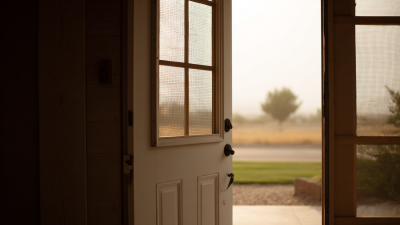The Ultimate Guide to Choosing Energy Efficient House Doors for Homeowners
When it comes to enhancing the energy efficiency of your home, selecting the right house doors is a decision that can significantly impact both comfort and utility costs. According to renowned industry expert Sarah Johnson, a sustainable architecture specialist, “Investing in energy-efficient house doors not only adds aesthetic value to your property but also serves as a crucial barrier against energy loss.” In her extensive work with homeowners, she emphasizes that the right choice can lead to substantial savings while also contributing to a greener environment.

With the increasing awareness of energy consumption and its effects on both the planet and personal finances, homeowners are encouraged to consider various factors before making a decision. From material choices to insulation properties, understanding the particulars of house doors is essential for sustainable living. This guide aims to equip homeowners with the knowledge needed to make informed decisions, ultimately leading to a comfortable and energy-efficient home. By exploring options and understanding the benefits of energy-efficient designs, homeowners can ensure their house doors are not just functional but also serve as a smart investment in their property’s future.
Understanding Energy Efficiency Ratings and Labels for House Doors
When selecting energy-efficient doors for your home, understanding energy efficiency ratings and labels is crucial. Energy-efficient doors are essential for maintaining comfortable indoor temperatures and reducing energy costs. According to the U.S. Department of Energy, up to 30% of a home's energy can be lost through inefficient doors and windows. Thus, identifying the right energy ratings such as the National Fenestration Rating Council (NFRC) labels can help homeowners make informed decisions. These labels provide vital information like U-factor, solar heat gain coefficient (SHGC), and visible transmittance, all crucial metrics for assessing a door's energy performance.
Tips: When examining the NFRC label, pay particular attention to the U-factor, which measures the door's insulation properties. A lower U-factor indicates better insulation, enhancing energy efficiency. Additionally, consider the SHGC rating; a lower SHGC is preferable in hotter climates, while a higher rating may be beneficial in cooler regions where sunlight can help reduce heating costs.
Moreover, many manufacturers offer ENERGY STAR® certified doors, which meet strict energy efficiency guidelines set by the Environmental Protection Agency. Selecting these certified products can lead to significant savings on energy bills while contributing to a more sustainable home environment. Remember, investing in quality, energy-efficient doors not only enhances your home’s value but also ensures long-term comfort and reduces environmental impact.
The Energy Efficiency Ratings of House Doors
This chart illustrates the energy efficiency ratings (R-values) of different house door materials. Higher R-values indicate better insulation performance, making fiberglass the most energy-efficient choice among the materials listed.
Exploring Material Options: Wood, Fiberglass, and Steel for Optimal Insulation
When choosing energy-efficient house doors, material selection plays a crucial role in optimizing insulation and overall home comfort. Among the top contenders are wood, fiberglass, and steel, each offering unique benefits tailored to different homeowner needs. Wood doors are renowned for their aesthetic appeal and natural insulation properties, making them a classic choice. Although they may require more maintenance, advancements in treatment have improved their durability and energy efficiency.
Fiberglass doors, on the other hand, are gaining popularity due to their resilience and low maintenance requirements. They can mimic the appearance of wood while providing superior insulation and resistance to warping. Steel doors are another excellent option, known for their strength and security. When properly insulated, they can effectively keep out the cold, contributing to a comfortable indoor environment.
Tips: When selecting your door, consider the climate of your area. In colder regions, a steel door with good insulation may provide the best energy efficiency. For homes where aesthetics are important, fiberglass can offer the beauty of wood without the added upkeep. Always check for Energy Star ratings, as they signify doors that provide better insulation and energy savings.
The Role of Door Frame Energy Efficiency in Home Thermal Performance
 When homeowners consider energy efficiency in their dwelling, the role of the door frame often goes overlooked. A well-constructed door frame is crucial for preventing air leaks, which can compromise the thermal envelope of a home. If the frame is poorly fit or made with subpar materials, gaps may form, allowing cold drafts in and conditioned air out. This not only undermines the effectiveness of insulation but also leads to increased energy consumption as heating and cooling systems work harder to maintain comfortable temperatures.
When homeowners consider energy efficiency in their dwelling, the role of the door frame often goes overlooked. A well-constructed door frame is crucial for preventing air leaks, which can compromise the thermal envelope of a home. If the frame is poorly fit or made with subpar materials, gaps may form, allowing cold drafts in and conditioned air out. This not only undermines the effectiveness of insulation but also leads to increased energy consumption as heating and cooling systems work harder to maintain comfortable temperatures.
Selecting an energy-efficient door frame involves more than just considering the door itself; it's essential to look at the materials and construction methods used. Frames made from insulated fiberglass or high-quality vinyl tend to provide superior thermal performance compared to traditional wooden frames. Moreover, ensuring a proper fit can further enhance efficiency. Homeowners should also consider features like weather stripping and gasketing, which help seal the door edges against airflow, thereby maximizing energy savings and comfort throughout the year.
How Proper Installation Enhances Energy Savings in House Doors
When it comes to energy efficiency in homes, the installation of house doors plays a pivotal role. According to the Department of Energy, proper door installation can reduce energy loss by an impressive 10 to 25 percent. This statistic highlights how even the slightest gaps or misalignments during installation can lead to significant air leakage, undermining the benefits of high-efficiency doors.
Furthermore, a study by the National Renewable Energy Laboratory reveals that properly sealed and installed doors can enhance overall HVAC efficiency, translating to lower utility bills. For instance, homes with energy-efficient doors that are installed correctly save an average of $300 to $500 annually on heating and cooling costs. Homeowners should prioritize hiring experienced professionals who understand the nuances of energy-efficient installations, as this not only maximizes savings but also prolongs the lifespan of the doors. Proper caulking and weather stripping during the installation process are key factors in achieving optimal performance and energy conservation.

Comparing Costs: Initial Investment vs. Long-Term Energy Savings in Door Choices
When homeowners consider upgrading their doors, the financial implications go beyond the initial purchase price. While energy-efficient doors may require a higher upfront investment, evaluating long-term savings is crucial. For instance, doors with high insulation ratings significantly reduce energy loss, leading to lower heating and cooling bills over time. This ongoing savings can often offset the initial costs within a few years, making energy-efficient options not just an environmentally conscious choice but a financially savvy one as well.
Moreover, different materials and technologies contribute varying levels of energy efficiency, each influencing both initial costs and energy savings. Fiberglass or steel doors typically provide better insulation compared to traditional wooden doors, resulting in more substantial energy reductions. Homeowners should weigh the long-term benefits of reduced energy bills alongside the cost of installation to make informed decisions. By prioritizing energy efficiency, homeowners can enhance their comfort, contribute to sustainability, and ultimately achieve savings that better align with their financial goals.
Related Posts
-

Innovative Garage Doors Showcase at 2025 China 138th Canton Fair Driving Industry Growth
-

How to Choose the Right Vinyl Doors for Your Home
-

The Ultimate Guide to Choosing the Perfect Screen Doors for Your Home
-

Transform Your Home with Innovative Screen Doors: Style, Functionality, and Protection
-

The Ultimate Guide to Choosing the Perfect Screen Doors for Your Home
-

Enhance Your Home’s Comfort: The Ultimate Guide to Choosing the Perfect Screen Doors











